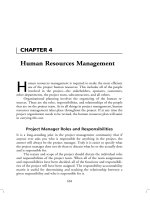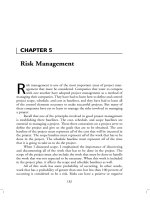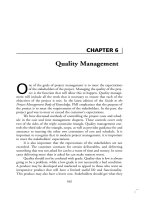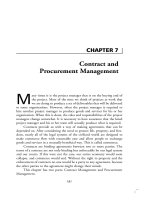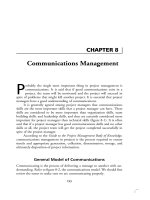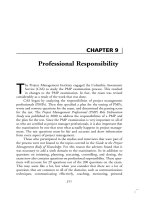Tài liệu PROJECT MANAGEMENT PRACTICE IN NIGERIAN PUBLIC SECTOR – AN EMPIRICAL STUDY docx
Bạn đang xem bản rút gọn của tài liệu. Xem và tải ngay bản đầy đủ của tài liệu tại đây (588.89 KB, 7 trang )
Australian Journal of Business and Management Research Vol.1 No.8 [01-07] | November-2011
1
PROJECT MANAGEMENT PRACTICE IN NIGERIAN PUBLIC SECTOR – AN
EMPIRICAL STUDY
OLATEJU, Olawale I.
Department of Business Administration and Management Technology,
Lagos State University, P.M.B. 0001, LASU POST Office Ojo, Lagos, Nigeria
ABDUL-AZEEZ, Ibraheem A. (corresponding author)
Department of Business Administration and Management Technology,
Lagos State University, P.M.B. 0001, LASU POST Office Ojo, Lagos, Nigeria
E-mail:
ALAMUTU, Salimonu A.
Department of Business Administration and Management Technology,
Lagos State University, P.M.B. 0001, LASU POST Office Ojo, Lagos, Nigeria
ABSTRACT
The application of Project Management (PM) tools and techniques in public sector is gradually becoming an
important issue in developing economies, especially in a country like Nigeria where projects of different size
and structures are undertaken. The paper examined the application of the project management practice in
public sector in Nigeria. The PM Lifecycles, tools and techniques were presented. The study was carried out in
Lagos because of its metropolitan nature and rapidly growing economy. Twenty three copies of questionnaire
were administered to 23 public institutions in Lagos to generate primary data. The descriptive analysis
techniques using percentages and table presentations coupled with coefficient of correlation were used for data
analysis. The study revealed that application of PM tools and techniques is an essential management approach
that tends to achieve specified objectives within specific time and budget limits through optimum use of
resources. Furthermore the study noted that there is lack of in-depth knowledge of PM tools and techniques in
public sector institutions sampled, also high cost of application was also observed by the respondents. The study
recommended among others that PM tools and techniques should be applied gradually especially in old
government institutions where resistance to change is perceived to be high.
Keywords: Project Management, Public sector, Practice, Nigeria
1. INTRODUCTION
Many definitions had been given to project by different authors, due to the fact that project is a multidisciplinary
word that has different meaning from different perspective and orientations. Engineers, Architects, Managers
and so on, have their definitions coined out from their experiences as far as their professions are concerned.
Project according to Project Management Institute, PMI, (2000) cited in Pinto (2007) “is a temporary activity or
endeavour undertaken purposely to create a unique output (product or service) within budget, time and
standards. Turner and Muller (2003) in their own words defined project as “an organization of human materials
and financial resources in a novel way, to undertake a unique scope of work, of given specification, within
constraints of cost and time, defined by quantitative and qualitative objectives so as to achieve a beneficial
change”.
The uniqueness of project is pointing to its genuine nature in the sense that there may not be a pre-existing blue
print for the project’s execution and there may not be a need to repeat the project once completed. Its goal
characteristics may be well perceive as achieving stated objectives or solve a particular problem, while its
temporary nature signifies a discrete, definable commencement and conclusion. Project management on the
other hand, according to Abbasi and Al-Mharmah (2000) “is the art and science of planning, designing and
managing work throughout all the phases of the project life cycle”. It is also regarded as a system or process of
planning, designing, scheduling, managing and controlling interconnected project activities in order to achieve
specific objectives or goal within a specific time, budget and standards (Lewis, 2007).
Project Management is an innovative management practice that tends to achieve stated or specified objectives
within specific time and budget limits through optimum use of resources (Stuckenbruck & Zomorrodian, 1987).
Australian Journal of Business and Management Research Vol.1 No.8 [01-07] | November-2011
2
It helps organization in investing their limited resources in the best way possible in order to achieve recurring
success and meeting the expectations of stakeholders. Government and organizations usually embark on
different projects with the aim of creating new service or improving the functional efficiency of the existing
ones. All these projects require appropriate skills and techniques that go beyond technical expertise only, but
encompass good and sound skills to manage limited budgets, and monitor shrinking schedules and unpredicted
outcomes, while at the same time dealing with people and organizational issues (Abbasi & Al-Mharmah, 2000).
The application of project management practice in public sector has been identified as an efficient approach
which would help in upgrading management capabilities and enable public sector to efficiently complete
projects and attain developmental objectives (Arnaboldi et al, 2004). It is also recognized as a key enabler with
whom public sector organizations adopting business improvement methodologies such as Lean Management
and TQM, improve their efficiency and competitiveness.
Studies have confirmed that application of modern project management methods and techniques has a great
effect on public institutions. Arnaboldi et al (2004) observed that application of project management strategy in
public sector was as a result of pressure on governments to abandon bureaucratic organization in favour of
leaner structures. The authors studied the projects carried out at Italian Treasury Ministry using project
management methodology and discover that proper implementation of project management concepts and
methods will help in avoiding project failure, continuous communication and the definition of project control
system. They however stated that, project management methods needed to be modified and specifically tailored
towards the needs of public institutions. In their study White & Fortune (2002) examined the current project
management practice in public sector in UK by collecting data from 236 project managers in some public
institutions. The study asked the respondents to judge the effectiveness of the project management methods,
tools, and techniques they had used on the project success. The result of the study revealed that 41% of the
reported projects were judged to be completely successful (using time, budget and specification), though some
drawbacks were reported. Similarly, Abbasi & Al-Mharmah (2000) explored the project management tools and
techniques used by the public sector in Jordan by surveying 50 industrial public firms. The study found out that
the use of project management tools and techniques among the public sector companies was considerably low,
but when practiced efficiently would result in tangible benefit in all aspects of planning, scheduling and
monitoring the time, cost and specifications of projects.
In Nigeria, the implementation of modern project management tools, methods and techniques is still not well
established in public sector, this results into failure of public institutions and their contractors in performing
their duties concerning the budget, specifications and deadlines of the projects awarded. Studies have
recognized social and political systems, cultural blocks and lack of financial support as barriers to successful
project planning and execution in Nigerian public sector (Idoro & Patunola-Ajayi, 2009). Therefore this paper
aims at investigating the project management tools and techniques being used in Nigerian public sector, their
benefits, obstacles and drawbacks with a view of recommending appropriate actions. The study made use of 23
randomly selected public agencies and parastatals under the Lagos State government.
2. PROJECT MANAGEMENT PHASES
Project management phases otherwise known as project lifecycle refers to the stages in a project’s development.
Project lifecycle is important because it demonstrates the logic that governs a project. It also helps in developing
plans for carrying out the project. (Pinto 2007) identified four distinct project life cycle phases which are:
Conceptualization, Planning, Execution, and Termination.
Conceptualization according to Pinto (2007) refers to the development of the initial goal and technical
specification for a project. The scope of work is determined, necessary resources (people, money, material &
machine) identified, and important organizational contributions or stakeholders signed on. Also, feasibility study
is conducted at this stage to investigate whether the project can be continued or not. Planning is the stage in
which detailed specifications, schematic, schedules and other plans are developed. It is also a stage where the
project solution is further developed in as much detail as possible and steps necessary to meet the project’s
objectives are put in place. At this stage the individual pieces of the project called work packages are broken
down, individual assignments made, and the process for completion clearly delineated. Project schedule, the
actual work and the estimated cost of completion are also identified. Anything that might pose a threat to the
successful completion of the project is also identified at this stage. Finally all the project stakeholders must be
identified at this stage of the project so as to establish a communication plan that describes information needed
and the delivery method to be used to keep stakeholders informed (Patel, 2008).
Execution phase deals with actual performance of the work of the project. Progress is continuously monitored
and appropriate adjustments are made and variances recorded so as to maintain the original project plan. During
Australian Journal of Business and Management Research Vol.1 No.8 [01-07] | November-2011
3
project execution, project tasks are been carried out and progress information is being reported through regular
team meetings. The project manager uses this information to maintain control over the direction of the project
by measuring the performance of the project activities comparing the results with the project plan and takes
corrective actions as needed (Westland, 2006). Termination occurs when the completed project is transferred to
the customer, project documentation is handed over to the business, suppliers’ contracts terminated, project
resources released and the project closure communicated to all stakeholders. The final step is to conduct lesson
learned studies; to examine what went well and what didn’t. Through this type of analysis, the wisdom of
experience is transfer back to the project organization which will help future management teams.
3. PROJECT MANAGEMENT TOOLS AND TECHNIQUES
Different tools and techniques are used in managing projects for a desirable outcome. Some of these tools and
techniques are Work Breakdown Structure, Gantt Charts, PRINCE 2, Project Networks (Critical Path Method
and Programme Evaluation and Review Techniques), Project Sensitivity Analysis, Cost Benefit Analysis,
Graphical Evaluation and Review Technique (GERT), and Project Software. Work Breakdown Structure
(WBS) deals with breaking down of the projects into manageable individual components in a hierarchical
structure. Such a structure defines tasks that can be completed independently of other tasks, facilitating resource
allocation, assignment of responsibilities and measurement and control of project. Wysocki (2009) also
observed that it is a veritable tool for defining work packages and developing and tracking the cost and schedule
for the project. WBS provides a common framework for the natural development of the overall planning and
control of a project and is the basis for dividing work into definable increments from which the Statement of
Work can be developed and technical, schedule cost, and labour hour reporting can be established. Gantt chart
is a useful tool for planning and scheduling projects. It shows graphical representation of the duration of tasks
against the progression of time. It was developed by Henry Gantt in 1915 purposely for monitoring projects
progression and tracking. Gantt charts have become a common technique for representing the phases and
activities of project Work Breakdown Structure (WBS) so they can be understood by a wide audience all over
the world (Wysocki, 2009).
PRINCE 2 which connotes Project In Controlled Environment 2 is a process based method for effective project
management. It is a de facto standard used extensively by the UK government and is widely recognised in the
private and public sector, both in the UK and internationally. Its features includes, focus on business
justification, division of project into manageable and controllable stages, flexible in application at a level
appropriate to the project management team. PRINCE 2 basically describes product based planning, change
control technique and quality review technique. Project Sensitivity Analysis determines which variables have
the most potential to affect project. Variables include, task duration, success rate and costs, risks, lags between
predecessors and successors, project duration, total project cost and so on. It is also useful in decision-making
under uncertainty and risk. Cost Benefit Analysis (CBA) is one of the most widely accepted and applied
methods for project appraisal for large scale infrastructure in the public and private sector. CBA is a prescriptive
method that provides guidance on the criteria to take account in decision making, ensuring that the net aggregate
benefits to society outweigh net aggregate costs (Patel, 2008).
Graphical Evaluation and Review Technique (GERT) is a network analysis technique used in project
management that allows probabilistic treatment of both network logic and activity duration estimates. It is a
useful management tool for planning, coordinating, and controlling complex projects (Westland, 2006). The key
objective of GERT is to evaluate on the basis of the network logic and estimated duration of the activity and
derive inference about some activities that may not be performed. GERT can be used with a complimentary
network analysis evaluation techniques used in project management such as CPM and PERT. Critical Path
Method is also a project network analysis technique used to determine which sequence of activities (path) has
the least amount of scheduling flexibility and therefore will most likely determine when the project can be
completed. Programme Evaluation and Review Technique (PERT) is an event-and-probability based network
analysis system generally used in projects where activities and their durations are difficult to define. PERT is
often used in large programme where the project involves numerous organizations at widely different locations.
4. RESEARCH METHODOLOGY
In order to analyze the practice of project management by the public institutions in Lagos Nigeria, survey
research approach was adopted. This was used because of its advantages of identifying attributes of a large
population from a group of individuals, the economy of the design and the rapid approach in data collection
(Luthans & Davis, 1982). The sample selected for this study consisted of 23 randomly selected public
institutions under Lagos State Government, such as Lagos State Water Corporation (LSWC), Lagos
Metropolitan Area Transport Authority (LAMATA), Lagos State Waste Management Authority (LAWMA),
Lagos State Ministry of Transport, Lagos State Ministry of Works and so on. Questionnaire was used as an
Australian Journal of Business and Management Research Vol.1 No.8 [01-07] | November-2011
4
instrument of data collection with the aim of collecting information about project management practices in the
public sector, the reasons behind using Project management tools, benefits, problems and obstacles. Relevant
statistical analysis was conducted on the collected data to explore different issues of this research. The
questionnaire was filled out by interviewing the person in charge of the each agency’s project planning and
management. This method enhanced the data accuracy and seriousness, also it account for 100% response rate
achieved in the data collection. The questionnaire was designed from review of related literature to the study. It
was pre-tested with five managers from the sample size in order to check and ensure that no irrelevant questions
were present.
5. RESULTS AND DISCUSSION
Table 1 covered personal characteristics of the respondents’ such as sex, educational qualification and work
experience. The data from the table shows that males constitute 73.9% of the respondents while 26.1% are
females. Also from the table, respondents with bachelor’s degree rank highest with 48.7% followed by Masters’
degree holders with 34.8% while the remaining 17.4% have professional qualifications. As noticed, all the
respondents are educated therefore this provides a solid base for understanding, better usage and implementation
of project management techniques and tools. Further observation of the table revealed that majority of the
respondents have worked more than five years in the institutions under study, this translates to the fact that they
are well grounded in the organization and can give accurate information as far as the subject matter is
concerned.
Table 2 shows tools and techniques of project management being employed in the sampled public agencies in
Lagos state. The respondents were presented with 11 options and were asked to indicate which had been used in
their agency’s project. The options included in the list were those found in standard textbooks on project
management. Respondents were also encouraged to include any tools or techniques not mentioned, if necessary.
Table 2 shows percentage of frequency of use and confidence interval.
Table 1: Personal characteristics of the Respondents
Sex of the Respondents
No
%
Male
17
73.9
Female
06
26.1
Highest Qualification
B.sc/HND
11
47.8
Master’s degree
08
34.8
PhD
-
-
Professional qualification
04
17.4
Working Experience (years)
1-5
02
8.7
6-10
08
34.8
11-15
10
43.5
16-20
03
13.0
Above 20 years
-
-
Source: Field survey, 2010
The analysis of the table shows that Gantt chart is the most frequently used tools with 64%, Cost Benefit
Analysis 58%, Statement of Work 30%, Work Breakdown Structure 26%, project management software (18%),
and other decision making techniques 13%. Project Sensitivity Analysis, PRINCE 2, PERT and CPM, GERT
are some of the rarely used or not employed tools by the agencies. This really shows that project management
tools and techniques are still not well implemented in most of the public agencies surveyed.
Table 2: Project management tools and techniques employed
Technique/tools
Percentage (%)
95% Confidence interval
Work Breakdown Structure
26
7.6 – 36.4
Statement of Work
30
15.1 – 46.3
Critical Path Method
3
0.0 – 9.4
Project Sensitivity Analysis
6
0.0 – 12.1
PRINCE 2
-
-
Gantt chart
64
52.4 - 83.6
Cost Benefit Analysis
58
36.6 – 71.5
Programme Evaluation and Review
Technique
-
-
Australian Journal of Business and Management Research Vol.1 No.8 [01-07] | November-2011
5
Graphical Evaluation and Review
Technique
-
-
Project Management Software
18
4.2 – 29.5
Other decision making techniques
13
3.4 – 21.7
Source: Field Survey, 2010
In Table 3, the obstacles facing the application of project management tools and techniques in public agencies
were analysed. As shown, the crucial obstacle is lack of project management knowledge (75%) – most of the
respondents are not well trained in the art of project management – therefore to apply PM tools and techniques
in all PM life cycle become serious problems. Other obstacles stated by the respondents are; change of authority,
lack of leadership commitment, bribery and corruption, low level of professional training in PM, and rigid
organizational structure.
Table 3: Obstacles facing PM implementation
Obstacles
Percentage (%)
95% Confidence interval
Lack of professional training
40
21.2 – 56.2
Lack of PM knowledge
75
55.4 – 88.4
Bribery and corruption
45
22.3 – 56.7
Lack of leadership commitment
25
19.1 – 40.9
Incessant change of authority
28
11.7 – 44.6
Rigid organizational structure
31
14.3 – 48.2
Source: Field Survey, 2010
Perceived benefits of employing project management tools and techniques were examined in Table 4. All the
respondents believed that if PM tools and techniques are well applied, it would lead to reduction in cost and
time overruns and more project success. As revealed by Table 4, 75% believed that it would afford the
opportunity of tracking the project progress, 67% believed that it would enhance better communication, while
61% perceived that PM tools would lead to good management of resources. Other benefits stated by the
respondents are; better work organization, defined goals and objectives, better time utilization and better quality.
This is in line with the study of Abbasi and Al-Mharmah (2000) that discovered that among other benefits,
knowing work progress and having better work organization are highly perceived benefits of PM tools and
techniques application.
Table 5 revealed that high cost is the major drawback observed in application of PM tools and techniques. Other
drawbacks observed by the respondents are; lack of expertise, weak interface with customers and difficult to
model real world.
Table 4: Perceived benefit of applying PM tools and techniques
Perceived benefits
Percentage (%)
95% Confidence interval
Better communication
67
57.7 – 86.1
Good management of resources
63
55.4 – 84.7
Known work progress
73
52.6 – 88.7
Defined goals and objectives
55
32.5 – 72.9
Better Quality
58
34.6 – 75.6
Better work organization
52
31.3 – 67.2
Better Time utilization
60
42.8 – 77.5
Source: Field Survey, 2010
Table 5: Drawbacks affecting application of PM tools and techniques
Drawbacks
Percentage (%)
95% Confidence interval
Lack of expertise
66
49.2 – 75.8
Weak interface with customers
40
22.4 – 57.6
High cost of application
83
57.3 – 79.7
Difficulty in modelling real world
52
32.1 –69.5
Source: Field Survey, 2010
Table 6 shows the opinion of the respondents on how to improve the application of PM tools and techniques in
public sector. Provision of adequate training in PM to all the person in charge of project, recruitment of project
management professionals, higher commitment from the government, establishment of Project Management
Office (PMO) in each of the agency are some of the suggested solutions by the respondents.
Australian Journal of Business and Management Research Vol.1 No.8 [01-07] | November-2011
6
Table 6: Suggestion for improving application of PM tools and techniques
Suggestions
Percentage (%)
95% Confidence interval
Recruitment of PM professionals
72
51.4 – 83.7
Higher commitment from government
54
30.1 – 68.4
Establishment of PMO
49
25.6 – 60.3
Provision of adequate PM training
68
57.4 –87.8
Source: Field Survey, 2010
Correlation coefficients among different factors that could affect the level of application of PM tools and
techniques, the obstacles, and the perceived benefits were analysed and shown in Table 8. Some of the factors
considered are; type of business, cost of application, age of the agency, employee experience, government
commitment and total number of employees. The result indicated that age of the agency and government
commitments have negative correlations with applying PM tools, obstacles and perceived benefits. Therefore, it
can be inferred that old government institutions are still resisting the application of PM tools and techniques;
also the government is not doing enough in entrenching the tools and techniques of PM in most of its
institutions.
Table 7: Correlation coefficients
Applied PM tools and
techniques
Obstacles
Perceived benefits
Type of business
0.365
0.481
0.375
Cost of implementation
0.435
0.361
0.257
Age of the firm
-0.453
-0.425
-0.361
Employee experience
0.621
0.583
0.232
Government commitment
-0.532
-0.485
0.379
Total number of employee
0.524
0.427
0.386
Source: Data Analysis, 2010
6. CONCLUSION
Applying PM tools and techniques in public institutions has become an important issue in many developing
countries, due to its successful application in private organizations and its proven effectiveness and flexibility in
attaining project goals and objectives. Due to its nature as the nation’s commercial capital and mega city, Lagos
is witnessing unprecedented capital projects in all the facet of developments, which require better application
and utilization of efficient, and effective management tools and techniques. Studying the application of PM tools
and techniques in public sector in Lagos would serve as eye openers to the government and other decision
maker to better plan their effort toward efficient application of PM tools and techniques. If properly applied, PM
tools and techniques would result in concrete benefits in all aspects of project planning, scheduling and
controlling the cost, time and quality.
Educational qualification of the respondents revealed that good majority of the sampled population are well
educated which provide a solid base for better utilization and application of PM tools and techniques. Gantt
charts, WBS and CBA are some of the applied PM tools and techniques by the respondent because of their
simple and understanding nature, however, lack of in-depth knowledge of these tools and techniques still form a
crucial obstacle facing application. In terms of perceived benefits, the consensus is that applying PM tools
efficiently will help in project tracking, better communication, better resource utilization and better quality
among others. The drawbacks in form of high cost, lack of expertise in PM and difficulty in real world
modelling are mentioned by the respondents. To tackle the drawbacks, the respondents believed that adequate
training should be given to the employee in art of PM, professionals in PM should be employed and Project
management Offices should be established across the government institutions. In views of the findings of this
research, the authors recommended the following actions, for proper application of PM tools and techniques in
Lagos State and Nigeria in general;
(i) Compatible organizational form should be chosen (matrix or pure projectised) so as to make the
application of PM tools and techniques consistent with culture and political environment of the
government institutions.
(ii) Project management tools and techniques should be applied gradually especially in old government
institutions where resistance to change perceived to be high. Drastic application should be avoided
so as not to lead to disruptive changes such as power struggles, loss of job management
embarrassment (Struckenbruck & Zomorrodian. 1987).
Australian Journal of Business and Management Research Vol.1 No.8 [01-07] | November-2011
7
(iii) Government should step up its commitment in applying PM tools and techniques in its entire project.
The bureaucracy that has entrenched itself in all government businesses should be controlled as far
as all government projects are concerned, so as not to become inefficient and unproductive.
(iv) As suggested by the respondents, Project Management Offices should be established across all the
government institutions with aim of managing, monitoring and controlling the projects embarked
by their institution. This will enhance efficient and effective application of PM tools and
techniques.
(v) Adequate PM training should be given to employee in charge of projects; this would increase the
knowledge of employees about different PM tools and techniques available for appropriate choice.
Also PM professionals should be employed for proper and adequate application of PM tools and
techniques.
(vi) Lastly, proper application of PM tools and techniques can serve as a vehicle for change. It can
constitute a wonderful training ground for future managers and skilled workers, and be an effective
means of bringing about administrative reform in public institutions.
REFERENCES
1. Abbasi, Y. G. & Al-Mharmah (2000) ‘Project management practice by the public sector in a
developing country’ International Journal of Project Management, 18(3), pp105-109.
2. Arnaboldi M., Azzone G., & Savoldelli A. (2004) ‘managing public sector project: the case of the
Italian Treasury Ministry’ International Journal of Project management, 22(3), pp213-223.
3. Idoro, G. I & Patunola-Ajayi J. B. (2009) ‘Evaluating the strategies for marketing project management
system in the Nigerian construction industry’, Nordic Journal of Surveying and Real Estate Research,
6(2), pp.25-36.
4. Lewis, J. P. (2007), ‘Fundamentals of Project Management, 3
rd
ed, New York: AMACOM.
5. Luthans, F., & Davis, T.R.V (1982) ‘An Idiographic Approach to Organizational Behavior research:
The Use of Single Case Experimental Designs and Direct Measures’, Academy of Management Review,
JSTOR, [Online]. Available form:
(Assessed: 3 November 2010).
6. Muller, R. & Turner, R. (2007) ‘Matching the project manager’s leadership style to project type’.
International Journal of Project Management, 25(4), pp. 21-32, DOI:10.1016/j.ijproman.2006.04.003,
ScienceDirect database, [Online]. Available from:
(Accessed: 1 September
2010).
7. Patel, B. M. (2008) ‘Project Management: Strategic financial planning, evaluation and control’;New
Delhi, Vikas Publishing House PVT Ltd.
8. Pinto, J.K. (2007) Project Management: Achieving Competitive Advantage, Upper Saddle River, NJ:
Pearson Education.
9. Stukenbruck L. C. & Zomorrodian, A. (1987) ‘Project Management: the promise for developing
countries’ Project Management, 5(3), pp.167-175.
10. Westland A. (2003) ‘Project Management Lifecycle’, London, Kogan Rage Limited.
11. White, D. & Fortune, J. (2002) ‘Current practice in project management – an empirical
study’International Journal of Project Management, 20(6), pp.1-11.
12. Wysocki, R. K. (2009) ‘Effective Project Management: traditional, agile, extreme, 5
th
ed, Indianapolis,
IN :Wiley Publishing.



